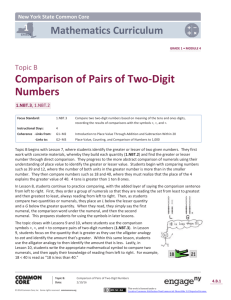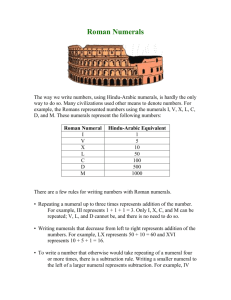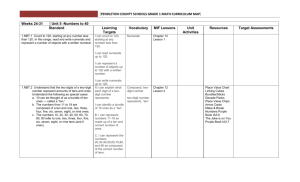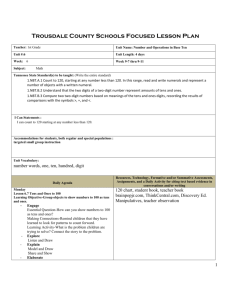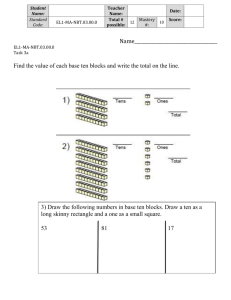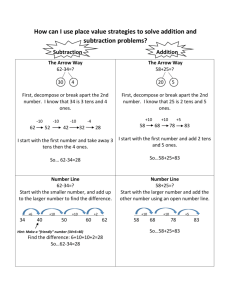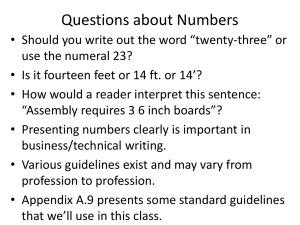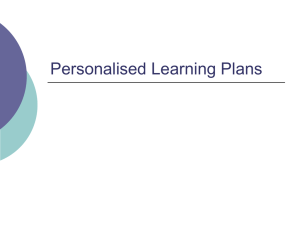Math4.1.NBT
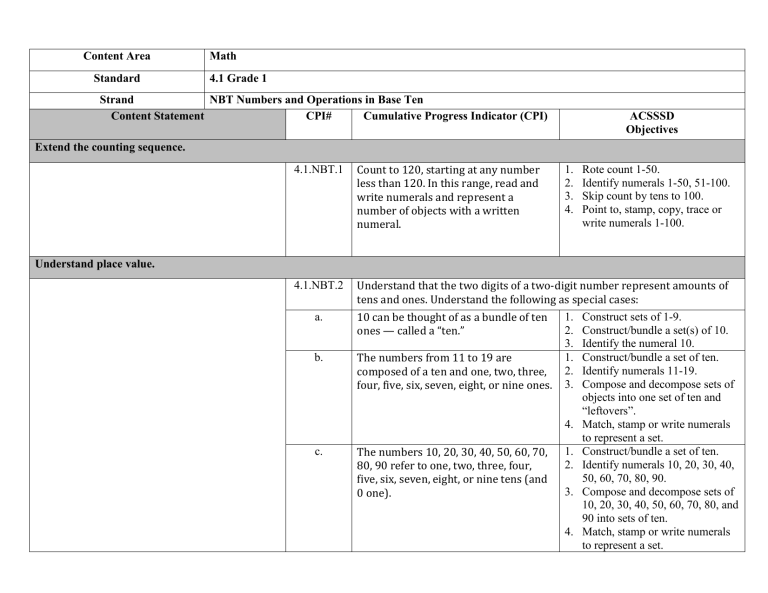
Content Area
Standard
Math
4.1 Grade 1
Strand
Content Statement
NBT Numbers and Operations in Base Ten
CPI# Cumulative Progress Indicator (CPI)
Extend the counting sequence.
Understand place value.
4.1.NBT.1
Count to 120, starting at any number less than 120. In this range, read and write numerals and represent a number of objects with a written numeral.
ACSSSD
Objectives
1.
Rote count 1-50.
2.
Identify numerals 1-50, 51-100.
3.
Skip count by tens to 100.
4.
Point to, stamp, copy, trace or write numerals 1-100.
4.1.NBT.2
Understand that the two digits of a two-digit number represent amounts of a. b. c. tens and ones. Understand the following as special cases:
10 can be thought of as a bundle of ten ones — called a “ten.”
The numbers from 11 to 19 are composed of a ten and one, two, three, four, five, six, seven, eight, or nine ones.
The numbers 10, 20, 30, 40, 50, 60, 70,
80, 90 refer to one, two, three, four, five, six, seven, eight, or nine tens (and
0 one).
1.
Construct sets of 1-9.
2.
Construct/bundle a set(s) of 10.
3.
Identify the numeral 10.
1.
Construct/bundle a set of ten.
2.
Identify numerals 11-19.
3.
Compose and decompose sets of objects into one set of ten and
“leftovers”.
4.
Match, stamp or write numerals to represent a set.
1.
Construct/bundle a set of ten.
2.
Identify numerals 10, 20, 30, 40,
50, 60, 70, 80, 90.
3.
Compose and decompose sets of
10, 20, 30, 40, 50, 60, 70, 80, and
90 into sets of ten.
4.
Match, stamp or write numerals to represent a set.
4.1.NBT.3
Compare two two-digit numbers based on meanings of the tens and ones digits, recording the results of comparisons with the symbols >, =, and
<.
5.
Show or tell how many sets of ten represent a given numeral:
10, 20, 30, 40, 50, 60, 70, 80 or
90.
1.
Identify/recognize two-digit numerals 11-50.
2.
Decompose a set of objects into sets of tens and “leftovers”.
3.
Match, stamp, or write numerals to represent a set.
4.
Identify the concepts of more, less and equal.
5.
Identify the symbols >, =, <.
6.
Demonstrate an understanding of the symbols >, =, <.
Use place value understanding and properties of operations to add and subtract.
4.1.NBT.4
Add within 100, including adding a two-digit number and a one-digit number, and adding a two-digit number and a multiple of 10, using concrete models or drawings and strategies based on place value, properties of operations, and/or the relationship between addition and subtraction; relate the strategy to a written method and explain the reasoning used. Understand that in adding two-digit numbers, one adds tens and tens, ones and ones; and sometimes it is necessary to compose a ten.
1.
2.
3.
4.
5.
6.
Identify numerals to 100.
Construct/bundle sets of 10.
Match or write numerals to represent a set.
Decompose sets from 11-20 into sets of tens and “leftovers”.
Demonstrate the ability to join two sets and decompose that set into tens and “leftovers”.
Count by tens to 100.
4.1.NBT.5
Given a two-digit number, mentally find
10 more or 10 less than the number, without having to count; explain the reasoning used.
4.1.NBT.6
Subtract multiples of 10 in the range
10-90 from multiples of 10 in the range
10-90 (positive or zero differences), using concrete models or drawings and strategies based on place value, properties of operations, and/or the relationship between addition and subtraction; relate the strategy to a written method and explain the reasoning used.
1.
Construct sets from 1-10.
2.
Represent two digit numerals by constructing sets of tens and ones.
3.
Match, copy, trace or write numerals to represent a two-digit number.
4.
Understand the concepts of
“adding” and “taking away”
1.
Identify numerals to 100.
2.
Construct sets of 10.
3.
Match or write numerals to represent a set.
4.
Represent/match numerals 10,
20, 30, 40, 50, 60, 70, 80, and 90 with sets of tens.
5.
Understand the concept of
“taking away”.
6.
Identify symbols used in mathematical equations.
7.
Trace, copy or write an equation.
